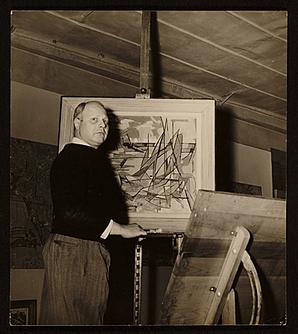© 2024 Waterline Art. All Rights Reserved.Terms & ConditionsPrivacy Policy
© 2023 Waterline Art. All Rights Reserved.Terms & ConditionsPrivacy Policy
60 x 46 in.
62 x 48 in. (framed)
Andrew Crispo Gallery, New York
Estate of Carl Holty, New York
Jody Klotz Fine Art, Abilene, TX

Carl Holty (1900-1973)
Carl Holty was born in Freiburg, Germany in 1900, to American parents who were abroad while his father pursued medical studies. The family returned to to the U.S. before Holty’s first birthday, initially living near Green Bay, WI, before ultimately settling in Milwaukee. Displaying early artistic inclination, Holty received private instruction from the German painter Friedrich Wilhelm Heine, and during high school, served as art editor and chief cover designer for the yearbook and newspaper. By the age of 16, he was contributing political cartoons to a local anti-war publication.
In 1919, Holty enrolled in pre-medical studies at Marquette University, and briefly entered the Students’ Army Training Corps, stationed at Camp Grant, IL. Electing to move in a different direction from medicine, he spent the following summer at the Ox-Bow School of Art in Saugatuck, MI, with an interest in poster design. He then moved to New York, studying at the National Academy of Design and Parsons School of Design. A transitional period followed in Chicago, where he began producing crayon portraits for affluent patrons, before returning home to Milwaukee in 1923, where he established himself as a portraitist. Financial independence arrived in 1925 via his grandfather’s bequest, allowing for continued art instruction at the Milwaukee Art Institute.
From 1924 through the subsequent decade, Holty lived abroad, traveling extensively. In 1926, he reached Munich with the intent to enroll at the Royal Academy, but after meeting the painter Vaclav Vytlacil, he opted to join Hans Hofmann’s private school instead. Hofmann’s emphasis on conceptual drawing integrating tactile and visual perception, along with his push-pull theory of spatial illusion through color and shape, profoundly reshaped Holty’s practice and influenced his career's work. Holty and his wife settled in Switzerland after her diagnosis of tuberculosis in 1927, and while his direct study with Hofmann ended, tutelage continued via correspondence.
Following his wife’s death in 1930, he relocated to Paris where Robert Delaunay sponsored his 1932 entry into Abstraction-Création, a collective countering surrealism and figuration that included Piet Mondrian, Josef Albers, and Alexander Calder (the only other American). Holty’s curvilinear abstractions appeared in the group’s 1933 journal, yet his alignment lay closer to Cubism - particularly Juan Gris’ methodical style and Picasso’s "synthetic Cubism" - than Neo-plasticism, prompting his withdrawal from the group after one year. Works from this period also reflect engagement with the biomorphic abstractions of Wassily Kandinsky and Joan Miró, the latter later occupying Holty’s New York studio during the 1940s.
By 1935, Holty was back in New York, reconnecting with Hofmann, Vytlacil, and Stuart Davis. Invited by Vytlacil, he participated in discussions that led to the formation of the American Abstract Artists (AAA) group in 1936. The organization aimed to cultivate public appreciation for nonobjective art, organizing an inaugural exhibition that drew 1,500 visitors, despite unfavorable press coverage. Possessing rhetorical skill and European modernist experience, Holty swiftly assumed leadership, later serving as chairman and president until 1944, when he deemed the group’s objectives fulfilled.
In 1939, Holty joined the faculty of the Art Students League faculty. Nine years later, Milwaukee colleague Howard Thomas secured him an artist-in-residence post at the University of Georgia, where his style shifted from crisp abstractions toward loose, luminous, and painterly compositions that deployed vivid color contrasts to veil forms and generate surface tension.
Further academic appointments included Washington University in St. Louis, the University of California, Berkeley, Brooklyn College, and an artist-in-residence post at the University of Wisconsin-Milwaukee. Throughout the 1950s and 1960s, his work grew more abstract and expressive, contours softening to near-feathery edges. He worked canvases horizontally with broad brushes to prevent drips, circulating to ensure color planes converged from all edges, rather than receding frontally. In 1969, he co-authored with Romare Bearden The Painter’s Mind: A Study of Structure and Space in Painting.
Carl Holty died in New York in 1973, at the age of 72. His work can be found in prestigious private and institutional collections worldwide, including the Brooklyn Museum, Metropolitan Museum of Art, Minneapolis Institute of Art, Museum of Modern Art (MoMA), Smithsonian American Art Museum, Solomon R. Guggenheim Museum, the Whitney Museum of American Art, and many others. In 2020, he was the subject of a major posthumous retrospective at the Georgia Museum of Art at the University of Georgia, entitled Carl Holty: Romantic Modernist.
Sources: Smithsonian American Art Museum and the Johnson Collection.